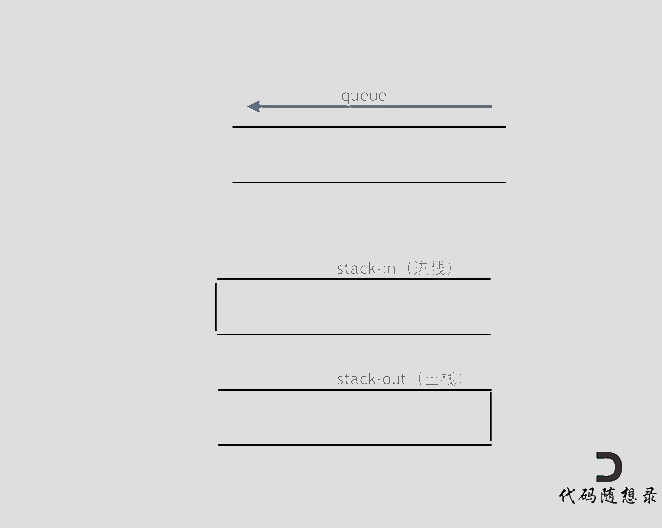用栈实现队列
本节对应代码随想录中:代码随想录,对应视频链接为:栈的基本操作! | LeetCode:232.用栈实现队列_哔哩哔哩_bilibili
习题
题目链接:232. 用栈实现队列
请你仅使用两个栈实现先入先出队列。队列应当支持一般队列支持的所有操作(push、pop、peek、empty):
实现 MyQueue 类:
void push(int x) 将元素 x 推到队列的末尾
int pop() 从队列的开头移除并返回元素
int peek() 返回队列开头的元素
boolean empty() 如果队列为空,返回 true ;否则,返回 false
说明:
- 你只能使用标准的栈操作 —— 也就是只有 push to top, peek/pop from top, size, 和 is empty 操作是合法的。
- 你所使用的语言也许不支持栈。你可以使用 list 或者 deque(双端队列)来模拟一个栈,只要是标准的栈操作即可。
输入:
["MyQueue", "push", "push", "peek", "pop", "empty"]
[[], [1], [2], [], [], []]
输出:
[null, null, null, 1, 1, false]
解释:
MyQueue myQueue = new MyQueue();
myQueue.push(1); // queue is: [1]
myQueue.push(2); // queue is: [1, 2] (leftmost is front of the queue)
myQueue.peek(); // return 1
myQueue.pop(); // return 1, queue is [2]
myQueue.empty(); // return false
我的解法
仅作为记录,非最优,可优化
一个栈只能后进先出,如果想实现先进先出那最少要两个栈。我的想法是需要输出的时候将 s1都 push 到 s2中,这样顺序就会反转,从而符合先进先出。当 push 元素的时候再把 s2的元素都 push 到 s1后,再将要 push 的元素放到 s1中,这样不难写出如下代码
class MyQueue {
public:
MyQueue() {
}
void push(int x) {
while (!s2.empty()) {
s1.push(s2.top());
s2.pop();
}
s1.push(x);
}
int pop() {
if (s2.empty()) {
while (!s1.empty()) {
s2.push(s1.top());
s1.pop();
}
}
int res = s2.top();
s2.pop();
return res;
}
int peek() {
if (s2.empty()) {
while (!s1.empty()) {
s2.push(s1.top());
s1.pop();
}
}
int res = s2.top();
return res;
}
bool empty() {
if (s1.empty() && s2.empty()) {
return true;
} else {
return false;
}
}
stack<int> s1;
stack<int> s2;
};
官方解法
上面我的解法有几个地方可以优化。
①我每次 push 的时候都将 s2的元素 push 到 s1中。其实不必这样做,我们将 s2作为输出栈,s1作为输入栈,s2专门用于输出。s2不为空的时候那 pop 的时候直接 pop s2就行,而 s2为空时,再将 s1的元素都 push 到 s2中

②peek 和 pop 类似,只不过 peek 不用 pop 元素,我的解法中重复写了一遍代码,但更好的写法是封装成一个函数,调用函数;或者利用写好的 pop 函数,pop 后再 push 之前 pop 的元素
③判断是否为空的时候,直接 return s1.empty() && s2.empty(); 即可,这样更简洁
class MyQueue {
private:
stack<int> inStack, outStack;
// 封装成函数
void in2out() {
while (!inStack.empty()) {
outStack.push(inStack.top());
inStack.pop();
}
}
public:
MyQueue() {
}
void push(int x) {
inStack.push(x);
}
int pop() {
if (outStack.empty()) {
in2out();
}
int x = outStack.top();
outStack.pop();
return x;
}
int peek() {
if (outStack.empty()) {
in2out();
}
return outStack.top();
}
bool empty() {
return inStack.empty() && outStack.empty();
}
};
- 时间复杂度:push 和 empty 为 O(1), pop 和 peek 为均摊 O(1)。对于每个元素,至多入栈和出栈各两次,故均摊复杂度为 O(1)。
- 空间复杂度:O( n n n)。其中 n 是操作总数。对于有 n 次 push 操作的情况,队列中会有 n 个元素,故空间复杂度为 O(n)。